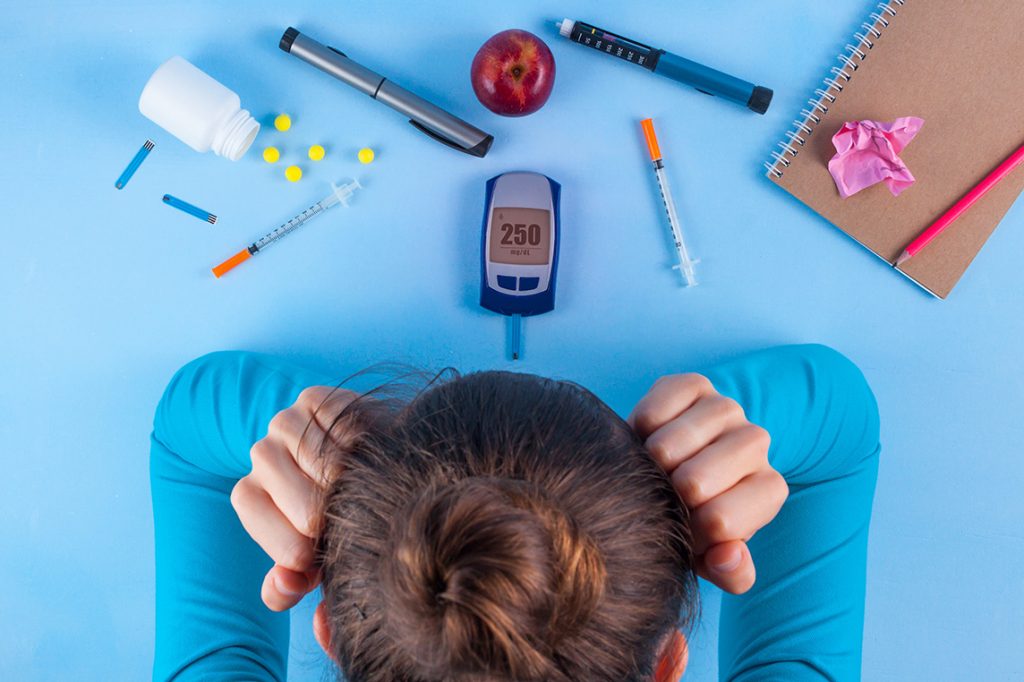Diabetes and Depression the Untold Truth

Having Type 1 Diabetes is a struggle in so many different ways, but most who don’t have it and are not around it on a daily basis may not fully understand how much of a mental drain it is. We have to play a constant game of pong with our blood glucose readings with bad short-term and long-term side effects if it goes above 180 mg/dL or below 80mg/dL never truly able to take a break from it. That alone is enough to give anyone “diabetic burnout” especially if they have no one else to turn to for help. The general public has been misled on diabetes since the explosion of type 2 diabetes in America with commercials making people think there is only one type of diabetes and that it can be cured with a good, moderated diet and exercise which is true for type 2 but not type 1’s which is an autoimmune disease that can’t be reversed.
For Type 1 diabetes there is no cure, yet (aside from a complete pancreas transplant, which can be both dangerous and expensive). This causes a majority of diabetics to lose hope that there will ever be a cure for them. Juvenile diabetics think that there is no potential for their life to change from the daily checking/ pricking their fingers, counting carbohydrates in every bite of food or sip of drink, and the daily injections/ correction dosing they have to make. Consuming calories is not the only thing that can potentially affect our numbers things like; exercise, lack of sleep, pain, sickness, certain medications, and stress (among myriad many other things) can mess with a diabetic’s blood sugar readings as well. This can be exasperating when you correctly figure insulin for food and your blood glucose level and still end up being high or low later.
There are certain products on the market that make the daily struggle easier like CGM’s (Continuous Glucose Monitors) so pricking can be less frequent and the trending direction of the glucose levels are better understood. An insulin pump cuts down on the number of injections a diabetic could take in a single day ( I have taken up to 12 injections a day before I got my pump). Digital carb counting applications on smartphones etc. However, none of these fantastic products make this disease fully go away. They do make having the disease more bearable for those who can afford them. This brings up another topic of depression for so many diabetics is the sheer cost of living with this disease.
According to the CDC Diabetes is one of the 5 most expensive long-term diseases to treat that someone could be diagnosed with. Heart disease, cancer, and diabetes are the leading causes of death and disability in the US. The cost for 1 vial of insulin in the US to someone without insurance is $174 – $300 depending on the type and brand of insulin. When it truly only costs $3 – $4 to manufacture. Add up the costs for test strips, needles, syringes, CGM’s, insulin pumps, supplies for infusion sets, medical insurance, doctor’s visits, hospitalizations, etc. the list goes on and on. The ADA says that a person with diabetes spends on average $16,752 per year on medical expenditures. That’s 2.3 times higher than someone who is not a diabetic. The stress of being able to afford this disease is insane. With the cost of not doing your best to take care of diabetes being far too great and ultimately the greatest price an untimely death.
The complications that arise from not taking care of your numbers is devastating. The list starts with any area in the body that has small blood vessels that maintain the supply of oxygen and glucose to the cells beginning with the brain, eyes, teeth, heart, kidneys, stomach, arms, fingers, legs, toes, the loss of feeling in extremities/ nerve pain, complications with pregnancy, skin and mouth conditions, etc. When the blood glucose is thick and cannot travel freely to these areas the cells are deprived of oxygen, insulin, and glucose which they need to nourish the cells. According to JDRF, the Juvenile Diabetes Research Fund depression affects 1 in every 4 people with diabetes and adolescents with type 1 have five times the rate of depression than those who were not diagnosed with diabetes. A Canadian study involving more than 1 million people aged between 15-25 years old has found that those with diabetes are 325% as likely to suffer an attempted suicide as people without it.
Obviously, there is a link between having diabetes and having depression. Even having things like a pump and a CGM which help treat the problem of not having a functioning pancreas for a patient that is only treating half the problem. We have to address the mental state of the patient and treat it accordingly. The burden of having diabetes financially, emotionally, physically, and on relationships with those helping care for us sometimes can be too much for anyone to juggle. We must find ways to help people battling this disease holistically, psychologically, and medically to maintain a healthy outlook and balanced life. Nobody is perfect and we must remember this and get the stereotype out of our minds that anybody really is perfect. It is only about self-improvement and if we do our best to make sure we are better than we were yesterday. When this is achieved diabetics universally can stop suffering from this disease and learn to thrive with it, until there is a cure and no one has to suffer from it
By: Miranda Montgomery (Type 1 diabetic for 20+ years) Admin for Type 1 Diabetes Support Group on Facebook with 12.3 K members
PolarBearMeds.com helps thousands of Americans each year get the Diabetes Medication and insulin they need. Save hundreds on popular brands such as Saxenda, Lantus, Humalog, Novolin, Apidra, and Novorapid. Pens, Vials, and Cartridges all shipped directly to your home from our partner pharmacy in Canada.

https://PolarBearMeds.com/?fbclid=IwAR0bPS8iLT8BWUODb9EN6c6h3usuPTFtEIivoLL6fhQIWq04JpjZK9MnOIw
